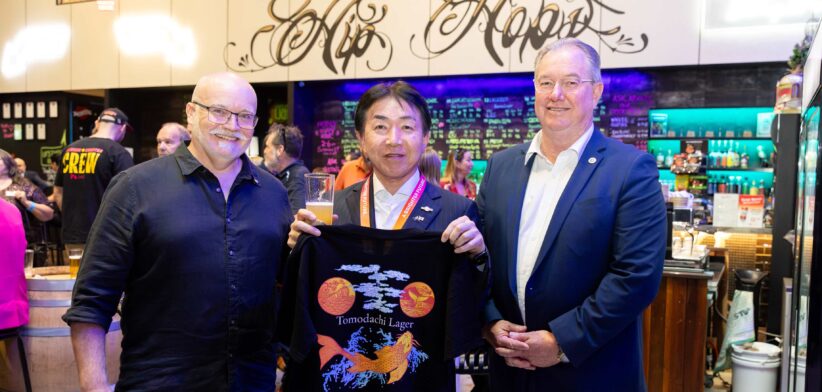South-east Queensland seaweed has been used to produce a “friendship” beer strengthening ties between the City of Moreton Bay and the Japanese city of Sanyo-Onoda.
City of Moreton Bay Mayor Peter Flannery said a collaboration with the University of the Sunshine Coast and Hip Hops Brewers led to the creation of the unique craft beer.
“The Tomodachi Lager – which translates to ‘friendship beer’ – is a fusion of Japanese flavours and Moreton Bay’s thirst for innovation and collaboration,” Mayor Flannery said.
“The Japanese-style rice lager features bright notes of Yuzu citrus and a subtle taste of seaweed, sourced locally and grown with the expertise of food scientists from UniSC.”
He said the collaborative beer was launched at a gift exchange at Brendale-based Hip Hops Brewers recently where a delegation from Sanyo-Onoda sampled the brew and shared tokens of friendship.
“Our 33-year partnership with Sanyo-Onoda is a great example of how friendship cities can inspire creative projects and strengthen economic and cultural ties.
“Through this initiative, we’ve deepened our relationship with UniSC and will continue to focus on collaborative opportunities that strengthen local businesses, drive economic growth, and enhance workforce and education outcomes for our City.”
Hip Hops Head Brewer Shaun Reeves said the project was a chance to experiment with new ingredients and brewing techniques while exploring Japanese traditions.
“Tomodachi Lager was a joy to create. It’s a refreshing take on a rice lager, with a distinctly Japanese twist thanks to the Japanese flavours of citrusy yuzu and seaweed umami,” Mr Reeves said.
UniSC Aquaculture Professor Nicholas Paul has been growing, studying and experimenting with seaweeds for decades, and said he was thrilled to contribute to such a unique brew.
“The sea lettuce we provided grows just off the coast here at Moreton Bay, but it’s actually very popular in Japan – where they call it aosa – and it’s used to boost the umami flavour of dishes,” Professor Paul said.
“Australians love their seaweed too, but it’s usually in the form of nori used in sushi rolls. We’re still just scratching the surface of how we can better utilise our amazing seaweeds.”








